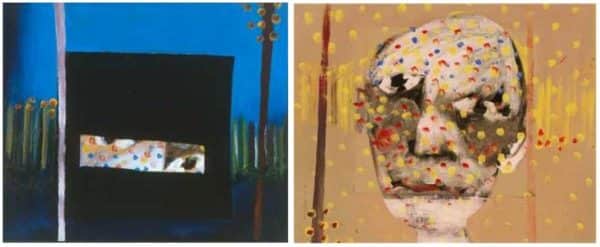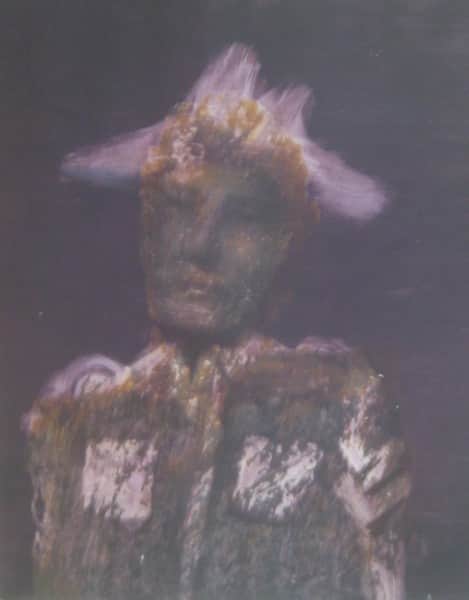As I write this, one day after the Centenary of Sidney Nolan’s birth on 22 April 1917, the Australian weekend papers – certainly those of the Fairfax Media – have double page spreads about him. Well briefed by a Media Release entitled Sidney Nolan’s man behind Ned Kelly mask revealed and issued by the Heide Museum of Modern Art, the newspaper articles feature a double photo with his 1945 painting Ned Kelly “Nobody knows anything about my case but myself” beside a reconstruction made from imaged pigments found buried underneath layers of paint to reveal a face behind the mask. The face is said to be that of the artist himself – a ‘Sid selfie’ in modern parlance. All can be seen as part of a virtual reality show at Heide for the next three weeks.

(left) Sidney Nolan, “Ned Kelly: ‘Nobody knows anything about my case but myself'” 1945, Heide Museum of Modern Art, Melbourne; (right) Digital colour recreation of first stage of the painting based on X-ray fluorescence
In contrast with the Centenary activities orchestrated in Britain by the Sidney Nolan Trust (of which more later), comparatively little has been organised in Australia. The Nolan Slates exhibition from University of Queensland Art Museum ran at Heide for seven months until early April 2017, Australia Post has issued a $1 Nolan stamp to mark the centenary, Heide is also mounting a series of Kelly talks, and the Art Gallery of New South Wales has belatedly added a Sidney Nolan Centenary program to its website. Beneath a lopped version of First Class Marksman, we are advised of two lectures, three artmaking activities for families and “an extended display of Nolan’s works drawn from the Gallery’s rich collection” (31 works of 147 are listed as hanging.)
I’ve been monitoring websites closely now for 12 months, and the exhibition and program listings, both current and forthcoming, of no major Australian gallery other than Heide of course, and AGNSW as above, mention activities relating to the Nolan Centenary. Perhaps it is merely a case of needing to update the websites. For example, I have heard that QAGOMA in Brisbane is planning to exhibit as many of Nolan’s original 1948 Fraser Island paintings as it can muster (probably just the four in Australian galleries), and NGV in Melbourne, at least according to The Age if not the NGV website, has a total of 25 of Nolan’s magnificent Wimmera works on display. However to the extent that planning for even the most esoteric subjects is available on gallery websites, the absence of any Nolan related material would seem to indicate that his Centenary has either eluded the vigilance of institutional forward planners, has exceeded their budgets or has been deliberately avoided.
Details of events planned for the Centenary, in both Australia and Britain, can be seen here on the nolancentenary.com.au website. The contrast between the differing approach in each country is stark.
Wide-ranging activities have been designed for Britain, with an emphasis on re-introducing Nolan to an English public that has largely forgotten him, whilst exploring influences Britain itself had on his art. The central thesis appears to be that whilst Nolan’s subjects remained Australian – whether Kelly, Mrs Fraser, Drought, the Inland, Burke and Wills, or Gallipoli – his myth-making, imaginings and paintings began to be tinged by an emerging and increasingly British vision that came with his residency. Be that as it may, the range of activities organised by the Trust is impressive, as is their execution in cooperation with partners such as Australia House, the Royal Academy of Arts, the British Museum and with major regional galleries such as Chichester’s Pallant House Gallery and Ikon Gallery in Birmingham. Other events are centred at The Rodd, Nolan’s home in Herefordshire, where his studio, untouched since his death 25 years ago, is now open to the public.
The Trust has also mounted an active social media campaign centred around The Nolan 100 – a delightful tribute from 100 individuals worldwide. People who knew Nolan, worked with him, or have been influenced by his work or his legacy were invited to choose a ‘favourite’ Nolan work and tell why. Their choices appear regularly throughout the year and many of them make fascinating reading for Nolan aficionados. The catalogue for the Pallant House exhibition Transferences: Sidney Nolan in Britain is impressive with many illustrations and six essays from fellow artists and Nolan scholars. A review can be read here. One article in particular should be compulsory reading – Kate McMillan writes compellingly of Nolan’s series of photographs showing carcasses of cattle and horses which, having died from thirst in the arid wasteland of a savage drought, lie desiccated beneath the burning sun.

Sidney Nolan, “Carcass”, 1952
She analyses how our art of landscape has effectively been complicit in “the absorption of certain histories at the exclusion of others. …. Only history-telling conducted in the margins,” she says, “has voiced the violent, state-sanctioned genocide of over 350 language groups across the continent.” She sees in these haunted images not just pastoral relics of a devastatingly bad drought, but a visible record of a “place unsettled and unsettling”, a badland. They “record the presence of a bad spirit”; indeed they portray “the rotting carcass of colonialism in miniature” and “speak back to a nation about itself, and to Britain of its colonial legacy.” She stops short of seeing the withered horse and cattle carcasses as a substitute, a metaphor perhaps, for the countless massacred Aboriginal bodies not left beneath the withering sun to desiccate, but burned to remove evidence of their slaughter. Once having made that connection though, who will ever again be able to look on these images of Nolan’s with the same eyes?
Finally, the online Centenary tribute Imagining in Excited Reverie on the website nolancentenary.com.au has commenced with tributes from Mirka Mora, Randolph Stow and Brian Adams. Links to their contributions are available here.
Why this difference in approach to Nolan’s Centenary between Australia and Britain? There is surely no one simple answer, but the most likely is probably the most obvious – with forward planning of major exhibitions in major galleries inevitably scheduled 2-3 years ahead if not longer, the fact of Nolan’s birth in 1917 simply went under the radar of those planning for 2017. Other possible reasons come to mind. Nolan was born just three days short of the second anniversary of Anzac Day and it is perhaps inevitable that his Centenary should be somewhat subsumed by the ongoing four year commemoration of the First War World. Some too would say Nolan’s apparent lack of recognition in Australia is consequent upon his desertion from the armed forces in WW2 and his dishonourable discharge – a view which seems to ignore what his canvasses say of conflict in war. We see too an increasing ‘corporatisation’ of art as its public funding diminishes in the face of competing demands and political priorities. I don’t know the figures, but it would not surprise if the total cost to the public purse of Australia keeping a handful of refugees in offshore island detention, has not exceeded the entire public funding of the Arts in Australia since Federation.
The fact though that such expenditure priorities reflect approval on both sides of politics and with a majority of the voting public, must give pause for thought. At NGA in Canberra nothing Nolanesque appears to be scheduled for 2017, although the 26 Kellys have been moved from their dedicated room to a far corner of the gallery. The vacated space is now the Book Shop – its vacated space at the main entrance now accommodating NGA Play where children engaged with the recent blockbuster Versailles: Treasures from the Palace, and will be similarly entranced next year when NGA hosts the glamorous world of the Maison Cartier and its clients. Politicians, Gallery Directors and Corporate sponsors alike are well aware that the public votes with its feet. As the Canberra Times reported in a page 6 item on the same day it carried the Nolan story on page 14, more than 190,000 paying visitors attended Versailles whereas less than 37,000 saw Arthur Boyd: Agony and Ecstasy in 2014. Would a Nolan exhibition have fared any better?
Whilst it seems Winston Churchill never did reply with “Then what are we fighting for?” when asked to cut arts funding to support the war effort, public versus private funding of the arts is a debate not going away soon. Judith White’s perceptive new book Culture Heist: Art versus Money, just published by Brandl & Schlesinger, is timely in breaking the silence about the covert struggle at the heart of our cultural institutions: the conflict between the public good and the forces of corporatisation. As Professor The Hon Dame Marie Bashir AD CVO, Governor of NSW from 2001-14 says, “Judith White has written with firsthand experience and passion about the centrality of every society’s need for a vibrant artistic culture.” This firsthand experience – as executive director of the Art Gallery Society of NSW for terms totalling 10 years, most recently in 2015 – may be the reason for an apparent sensitivity at AGNSW to criticism of its alleged paucity of involvement with Nolan centenary celebrations. In the recent newspaper article, denying that the milestone has been overlooked in Australia, the AGNSW curator of Australian art argues that Nolan’s importance is widely accepted and understood in Australia where he is a constant presence in our galleries, which is not so much the case in England. Such logic would have resulted in little commemorative activity marking the Anzac Day centenary two years ago!
Turning briefly to the face behind the mask. I doubt it was ever intended by Nolan to be a self portrait as such – it seems to me much closer to the Kelly death mask with which he was quite familiar. He references himself in the work, certainly – via the telltale red, white and blue spots as mentioned in the article, and by them covering his rendering of the death mask of Kelly with whom he identified as a fellow fugitive from the law – but he does not portray himself. The likeness to the death mask is evident in the illustration below, particularly the nose, the horizontal slit mouth and the widely spaced eyes. Nolan also referenced himself via the Kelly death mask in his 1954 painting Death of a Poet.

The newspaper article mentioned above reports that Nolan’s recent biographer Nancy Underhill believes that many of Nolan’s paintings were self portraits. Agreed – and few come as a better likeness than his 1969 painting of the non-existing poet Ern Malley seen below. On the verso of this image of a slouch-hatted soldier with a corporal’s twin-striped sleeve, Nolan has written this line from a Malley poem: “What would you have me do. Go to the wars?”

Sidney Nolan, Portrait of Ern Malley, 1969
One Comment
Join the conversation and post a comment.


Dear Mr Rainey,
I’m writing a short book about a long-ago murder in Melbourne with some interesting artistic connections: the victim, Mollie Dean, was at the time of her slaying in 1930 the model and lover of Colin Colahan. Mollie was also a schoolteacher, her formative years (1922-1926) at St Kilda’s Brighton Road State School overlapping with the young Sid Nolan – education department records suggest she was an outstanding teacher, who won a prize for her infant teaching. It caused me to wonder whether the bust of the young schoolmistress in Nolan’s 1944 “Brighton Road State School” (“Perspective Love Song”) might be Mollie; I can’t imagine Nolan missed the news of her death, which was a cause celebre in sober Melbourne. It may be, of course, that I’ve succumbed to that habit of the obsessed investigator, seeing my quarry everywhere! Yet I can’t help feeling intrigued and would appreciate your expert opinion.
Best regards,
Gideon Haigh